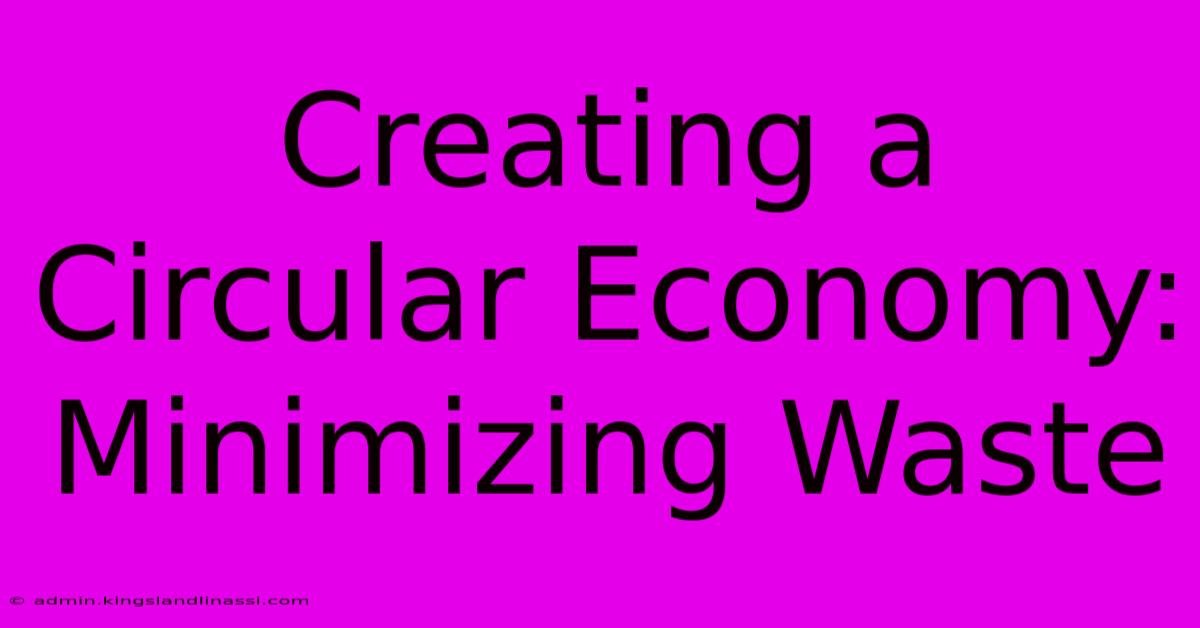Creating A Circular Economy: Minimizing Waste

Table of Contents
Creating a Circular Economy: Minimizing Waste
The linear "take-make-dispose" economic model is unsustainable. Our planet's resources are finite, and landfills are overflowing. The solution? Transitioning to a circular economy, where waste is minimized and resources are kept in use for as long as possible. This isn't just an environmental imperative; it's a path to economic growth and innovation. This article explores key strategies for creating a circular economy focused on minimizing waste.
Understanding the Principles of a Circular Economy
A circular economy operates on three core principles:
- Design out waste and pollution: Products should be designed from the outset with their end-of-life in mind. This includes using sustainable materials, making them easily repairable, and designing for disassembly and reuse.
- Keep products and materials in use: Extending the lifespan of products through reuse, repair, refurbishment, and remanufacturing is crucial. This minimizes the need for new resources and reduces waste.
- Regenerate natural systems: Circular economy practices should actively contribute to the restoration and regeneration of natural ecosystems. This means using renewable energy sources, minimizing pollution, and promoting biodiversity.
Key Strategies for Minimizing Waste
Several key strategies are essential for building a truly circular economy focused on waste reduction:
1. Reduce, Reuse, Recycle: The Foundation of Waste Management
This classic mantra remains vital. Reducing consumption is the most effective way to minimize waste. This involves thoughtful purchasing decisions, choosing durable and repairable products, and avoiding single-use items. Reusing items directly extends their lifespan, saving resources and energy. Finally, recycling ensures that materials are recovered and reused in new products. However, it's crucial to remember that recycling is a last resort; reducing and reusing should always be prioritized.
2. Design for Durability and Reparability
Designing products for longevity is critical. Durable products last longer, reducing the need for replacements. Reparability means that products can be easily fixed when they break, rather than being discarded. This requires manufacturers to use modular designs, provide readily available spare parts, and offer repair services. The right to repair movement is gaining traction, advocating for consumers' ability to repair their own devices.
3. Embrace Remanufacturing and Refurbishment
Instead of discarding used products, remanufacturing and refurbishment can give them a new life. Remanufacturing involves disassembling a product, replacing worn-out components, and rebuilding it to its original specifications. Refurbishment involves cleaning, repairing, and restoring a used product to a functional state. These processes extend the product's lifespan and reduce the demand for new materials.
4. Promote Sustainable Materials and Closed-Loop Systems
The materials used in product manufacturing significantly impact waste generation. Choosing sustainable materials like recycled content, bio-based materials, and renewable resources minimizes environmental impact. Closed-loop systems aim to keep materials within the production cycle for as long as possible, minimizing waste and reducing reliance on virgin resources.
5. Invest in Waste Management Infrastructure
Effective waste management infrastructure is essential. This includes improved sorting facilities for recycling, composting programs for organic waste, and efficient systems for managing hazardous waste. Investing in these systems is crucial for maximizing resource recovery and minimizing environmental damage.
The Benefits of a Circular Economy Focused on Waste Minimization
Transitioning to a circular economy offers numerous benefits:
- Reduced environmental impact: Minimizing waste reduces pollution, conserves resources, and protects biodiversity.
- Economic growth: Creating new industries and jobs focused on reuse, repair, and remanufacturing stimulates economic activity.
- Resource security: Reduced reliance on virgin materials enhances resource security and reduces vulnerability to supply chain disruptions.
- Improved public health: Reducing pollution and waste improves air and water quality, benefiting public health.
Conclusion: A Collaborative Effort
Creating a circular economy requires a collaborative effort involving governments, businesses, and consumers. By adopting the strategies outlined above, we can significantly reduce waste, protect our planet, and build a more sustainable and prosperous future. The journey towards a circular economy is ongoing, but the potential rewards are immense. Let's work together to minimize waste and build a better world.

Thank you for visiting our website wich cover about Creating A Circular Economy: Minimizing Waste. We hope the information provided has been useful to you. Feel free to contact us if you have any questions or need further assistance. See you next time and dont miss to bookmark.
Featured Posts
-
Hair Goals Achieved With Carols Daughter Goddess Strength
Apr 21, 2025
-
Tesla Net Worth Beyond The Headlines And Hype
Apr 21, 2025
-
Prodigal Son Lyrics A Comprehensive Analysis
Apr 21, 2025
-
Understanding Ayden Heavens Age
Apr 21, 2025
-
Kendrick Lamars Net Worth Beyond The Music
Apr 21, 2025
